A selection of the best varieties of hot peppers and tips for choosing them
Hot pepper is a universal seasoning for fish, meat and vegetable dishes, as well as a folk remedy for treating diseases. Pepper pulp contains more vitamin C than lemon. Eating hot peppers improves immunity and helps effectively fight bacteria and germs. Grow the plant in the garden, on the balcony or on the windowsill.
In this article we will look at which varieties of hot peppers produce the best harvest and what to look for when choosing.
The best varieties
Yield, marketability and taste depend on the choice of variety.. Some plants are suitable for growing in warm regions, while others show stable yields in the Urals and Siberia.
Purchase seeds from online stores or from familiar gardeners. Let's consider the best varieties of hot peppers with yield characteristics, cultivation characteristics and photos.
Queen of Spades
 The decorative variety Queen of Spades has an attractive appearance: small glossy fruits of red, yellow and purple colors stick out on the bush in all directions. The bushes are compact, the height does not exceed 40 cm. The leaves are dark green and small. Pepper length 10 cm, weight about 12 g.
The decorative variety Queen of Spades has an attractive appearance: small glossy fruits of red, yellow and purple colors stick out on the bush in all directions. The bushes are compact, the height does not exceed 40 cm. The leaves are dark green and small. Pepper length 10 cm, weight about 12 g.
In winter, the Queen of Spades is grown indoors. The variety is mid-season, 100-115 days pass from germination to technical maturity. In summer, the plant is planted in greenhouses or open ground.
Peppers have a rich aroma and taste and are used to make powder and universal seasonings.
Dragon tongue
Hot peppers ripens in 100-110 days from the moment the first shoots appear. The plant is immune to diseases and pests; about 90 fruits ripen on one bush at the same time. In the south, peppers are planted in open beds, in the north - in greenhouses and greenhouses. The fruits are deep red, glossy, elongated. The length of the pepper is 12 cm, weight is about 18 g. The bushes are powerful and spreading, reaching a height of 70 cm. The leaves are green, medium in size.
Interesting! The Dragon's Tongue variety is used to make paprika, spices and seasonings. The fruits have a strong pungent aroma and taste. Spices are actively used in Georgian, Korean, and Chinese cuisine.
Indian summer
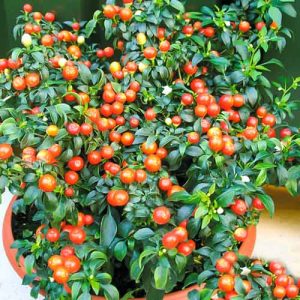
In summer the plant is grown on a balcony or loggia, in winter - on a windowsill. The variety is unpretentious in care, but requires regular watering and fertilizing with organic fertilizers.
The bushes are leafy, 30-40 cm high. The ripening period is about 4 months, the fruits are small, spherical. The peel is glossy, smooth, red. The mass of the pepper is 5 g, the wall thickness is 1 mm.
The fruits have a pungent taste and aroma, are universal in application.
Dragon
Hybrid peppers ripen in 120-130 days from planting. Suitable for growing outdoors and under film covers. The bushes are compact, about 60 cm in height. Spreading, with a developed root system.
The fruits are cone-shaped, ribbed, reach 12 cm in length. The weight of the pepper varies from 10 to 15 g, the wall thickness is 2-3 mm, the color is red. Zmey Gorynych has excellent commercial qualities. Shows stable yield - about 4 kg are harvested from 1 m².
Important! Hybrid Snake Gorynych is suitable for growing in regions with cool climates. It is cold-resistant and immune to sudden weather changes.Rarely gets sick and is not exposed to insect pests.

Bully
The plant reaches a height of 80 cm. The bush is leafy, semi-spreading. The harvest ripens in 120-130 days from planting. The fruits are trapezoidal, average weight 5-7 g. They have a yellow, red, orange color. The taste and commercial qualities are high; the peppers are distinguished by their semi-bitter and juicy pulp. The fruiting period is extended, the variety is universal in use.
Read also:
Homer
Homer hybrid is resistant to insect pests and easy to maintain. The plant is compact, suitable for growing in the garden and indoors. The length of the fruit is 18-22 cm, the color is light green. The pulp is dense, with a pronounced pungent taste. The Homer hybrid is suitable for fresh consumption and the preparation of canned and pickled dishes.
Important! To increase productivity, it is recommended to regularly feed the plant with organic and mineral fertilizers. Suitable solutions for this include Mortar, Kimira, ash solution, and superphosphate. Productivity also depends on where the pepper grows - it is recommended to plant it in warm and sunny areas that are protected from the wind. In the greenhouse, hot peppers coexist with cucumbers.
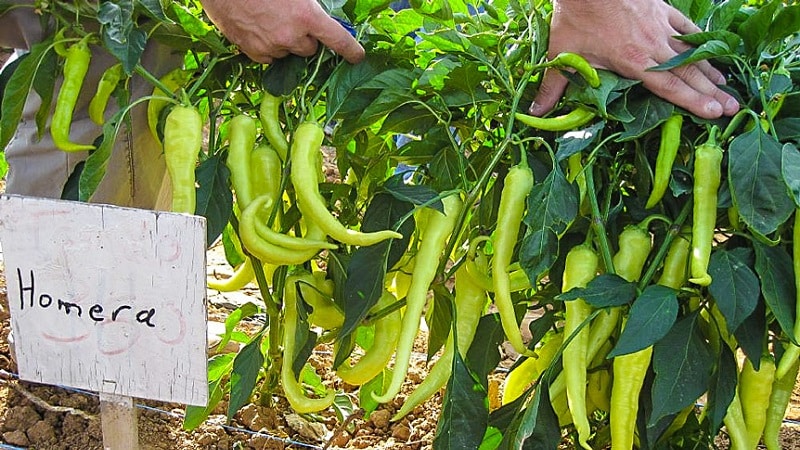
Dinosaur
The hybrid matures within 100 days from planting. Suitable for growing in any climatic conditions. Plant height 60 cm, leaves large, dark green. The fruits are elongated, 20-22 cm long. Weight is about 120 g, wall thickness is 4 mm. When ripe, peppers turn honey-yellow and acquire a glossy color. Gardeners value the hybrid for its unique taste - sweet and spicy.Dinosaur is universal in use, imparts a piquant taste and aroma.
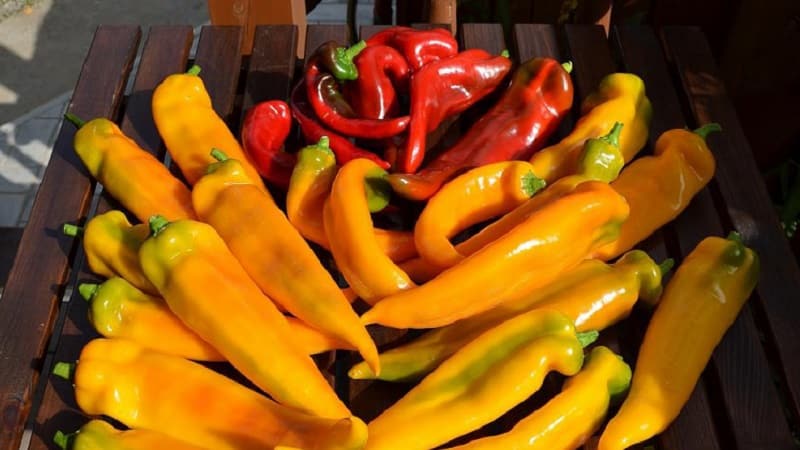
Adjika
Popular spicy Adjika pepper is grown in open ground. The variety does not require special agrotechnical rules for care. The fruits are bright red, elongated, conical in shape. Weight varies from 70 to 100 g, the pulp is juicy and thick. The variety is easily recognized by its classic pungent taste and pleasant aroma. Adjika is used in fresh, dried, and ground form.
Important! To obtain a rich harvest, Adjika is planted in seedlings. For planting, seeds and soil are disinfected and a suitable container is prepared. The variety is planted in the garden according to a 50x50 pattern.

Ram's horn
Middle late Ram's horn ripens in 130-140 days from the moment of germination of seedlings. The plant's foliage is average, its height is about 50 cm. The variety is sensitive to growing conditions, so loose and nutritious soils are chosen for planting.
The shape is cone-shaped, elongated. The average weight of pepper is 40 g, length 30 cm. The color is red, the flesh is juicy and hot, with a rich aroma. About 60 peppers are set on one plant, about 3 kg are collected from 1 m². The harvest is used fresh, for making seasonings and pickling.
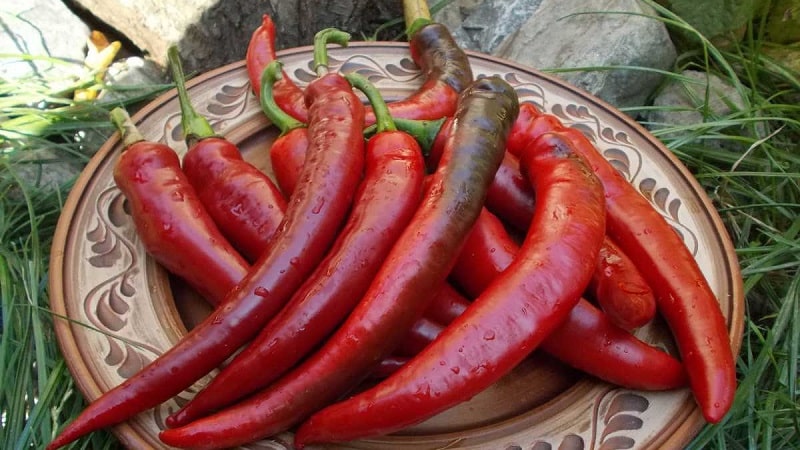
Cayenne
The average height of the plant is 90 cm. The leaves are light green and small. The variety is heat-loving and shows the best yield when planted in a greenhouse. The fruits are bright red, cone-shaped. Pepper weight 80 g, length 15-20 cm. The pulp is dense, with a bright peppery taste and aroma. In use Cayenne pepper universal - suitable for drying and heat treatment.
Chinese fire
The Chinese Fire variety is easy to grow. Ripens within 90 days from germination and is immune to sudden weather changes.Plant height is about 60 cm. The fruits are curved and cone-shaped. Weight varies from 50 to 80 g, length 25 cm. The taste is hot and pungent. Chinese fire is durable and suitable for transportation over long distances.
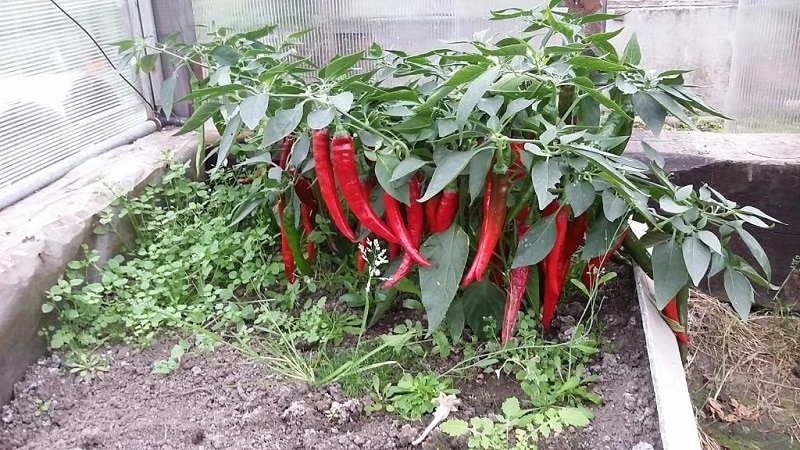
Astrakhansky 147
Compact plants are grown in open ground. Red peppers, weight 10 g, wall thickness 2 mm. The length of the fruit is 7 cm, the taste is semi-sharp. Astrakhan 147 has an extended fruiting period; from 1 m² they harvest from 1.5 to 3 kg of tasty and versatile fruits.
Interesting! Hot peppers are used for pickling and pickling. During the cooking process, vegetables retain their vitamin composition and strengthen the immune system during flu and colds.

The best variety of hot pepper for greenhouses
In regions with sudden weather changes, it is recommended to grow peppers in a greenhouse. The structure protects the plant from heavy rains, winds, fogs, and frosts.
The best varieties for greenhouses:
-
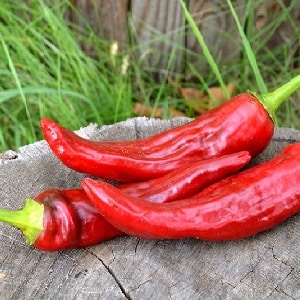 Anaheim hot pepper
Anaheim hot pepperGorky Ukrainian. The mid-season variety is planted as seedlings, following a 40x60 planting pattern. The bushes are miniature, height 25-30 cm. The fruits are cone-shaped and elongated, with a red glossy peel. The taste is richly spicy. Features long-term storage.
- Anaheim. This is a type of chili pepper that has an attractive green skin and a spicy flavor. The length of the fruit is 25 cm, weight 30-40 g. Anaheim pepper is added to sauces, seasonings and marinades. The pulp contains vitamins A, E and C.
- Impala. It is resistant to high humidity and is immune to viral and fungal diseases. Plant height 70 cm, leaves of medium size. The color is red, the taste is classic spicy. The weight of one pepper is about 80 g. It is universal in use and suitable for growing for sale.
And more about hot peppers:
Instructions for growing decorative peppers “Little Miracle”
Features and varieties of pepperoni pepper and its cultivation
For open ground
In the open ground resistant and easy-to-maintain varieties and hybrids are planted. They rarely get sick and show stable productivity regardless of weather conditions:
-
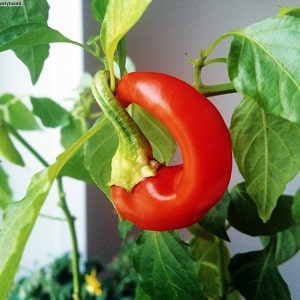 Indian elephant
Indian elephantIndian elephant. The harvest ripens in 100-110 days and is distinguished by high commercial and taste qualities. The bushes are powerful, semi-spreading, up to 130 cm in height. The fruits are dark red, cone-shaped. The mass of the pepper is 30 g, the wall thickness is 1 mm. The taste is sweet and sour, with a bright aroma.
- Dirk. The hybrid is planted as seedlings. The fruits are long and the skin is smooth. The weight of the pepper varies from 40 to 60 g, the wall thickness is 3 mm. The taste is mildly pungent and pleasant. The crop is universal in use - the fruits are consumed fresh or for preparing vegetable snacks and salads.
- Pietro It has attractive dark red fruits and a piquant aroma. Pepper weight is 30 g, length is about 15 cm. Hybrid Pietro is unpretentious in care, resistant to tobacco mosaic virus and fungal infections.
Choosing an early ripening variety
Early ripening varieties grown in the Urals and Siberia. Peppers Hot bouquet, Chinese fire, Double abundance ripen in 80-90 days from the moment the first shoots appear. In conditions of a short and cool summer, they do not have time to get sick; gardeners harvest within 3 months.
Mid-season varieties
Mid-season varieties ripen in 100-120 days. Peppers Queen of Spades and Gorky Ukrainian grown in central Russia. Mid-season varieties are characterized by stable yields, rapid fruit set, juicy and aromatic pulp.
Late ripening varieties
Late-ripening peppers Ram's Horn, Dirk, Cayenne ripen in 130-140 days. Such plants grown in the Moscow region and in the south of the country. They are easy to care for and have attractive commercial qualities.
Conclusion
Gardeners grow hot peppers of domestic and foreign selection. The vegetable is indispensable when preparing spicy and savory dishes; it is suitable for consumption fresh or dried. Pepper pulp is rich in vitamins and minerals, and in moderate quantities is good for health and strengthening the immune system.
The plant is grown in open ground, in a greenhouse or on a windowsill. A distinctive feature of hot pepper is that it can produce crops all year round. When choosing a variety, pay attention to ripening time, yield, and care.